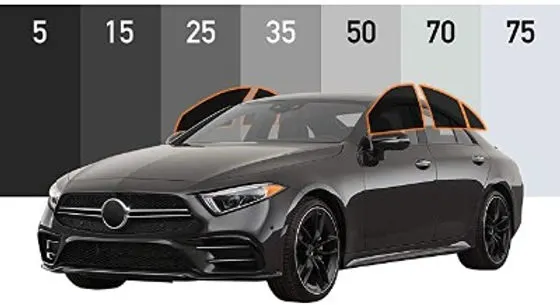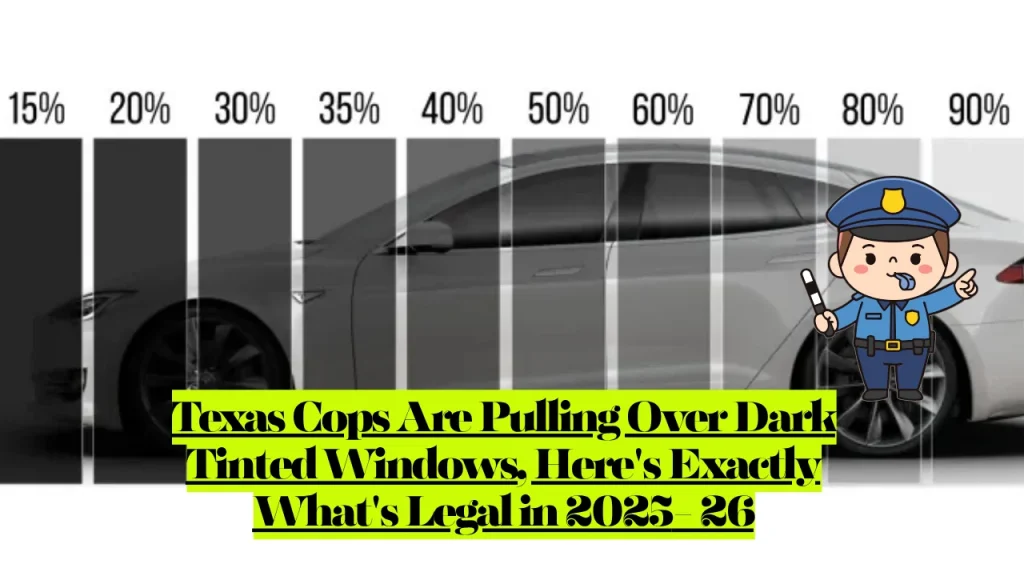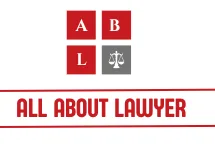Texas Cops Are Pulling Over Dark Tinted Windows, Here’s Exactly What’s Legal
Legal tint in Texas requires front side windows to allow at least 25% of light through—any darker and you’re looking at fines starting at $20, failed inspections, and escalating penalties up to $275. Front windshields can only be tinted above the AS-1 line or the top 5 inches, whichever is closer to the top. Texas cops now carry portable meters that instantly measure your tint during traffic stops.
Don’t let illegal tint cost you money and headaches.
What Is Legal Tint in Texas?
Texas Transportation Code §547.613 establishes specific tint darkness limits measured by Visible Light Transmission (VLT) percentage—the amount of light that must pass through your windows. The higher the VLT number, the more light passes through and the lighter the tint appears.
Texas law distinguishes between different window positions but applies the same rules to sedans, SUVs, and vans. This uniform approach simplifies compliance compared to many other states that set different standards for various vehicle types.
Texas Tint Law by Vehicle Type
Front Windshield
Tint can only be applied above the AS-1 line (a marking on most windshields) or the top 5 inches from the windshield’s top, whichever measurement is closer to the top. This strip—often called an “eyebrow” tint—reduces sun glare without obstructing your view while driving.
Any tint applied to the windshield must have at least 25% light transmission and cannot exceed 25% reflectivity. Clear UV-blocking films can be applied to the entire windshield without restriction since they don’t reduce visibility.
Front Side Windows (Driver and Passenger)
Front side windows must allow more than 25% of light to pass through when measured in combination with the window glass. This means if your factory glass already blocks 10% of light, your tint film can only block an additional 15% to stay legal.
Windows immediately to the right and left of the driver that have less than 25% light transmission will fail inspection, regardless of the vehicle’s model year.
Related article: What is The Legal Alcohol Limit? One Drink Over the Limit Could Cost You $10,000 Legal BAC

Rear Side Windows and Back Window
Texas exempts rear side windows behind the driver from all tint restrictions—you can apply any darkness level, including complete blackout tint.
The rear window can also be tinted to any darkness if your vehicle has outside mirrors on both sides that provide a 200-foot view behind the vehicle. Without dual side mirrors, the rear window must maintain 25% light transmission.
How Tint Darkness Is Measured
VLT (Visible Light Transmission) percentage indicates how much visible light can pass through your tint film combined with the window glass. A 50% VLT tint allows half the light through and appears relatively light, while a 5% VLT (often called “limo tint”) appears nearly black and blocks 95% of light.
Law enforcement officers use specialized light meters during traffic stops to measure VLT on the spot. These handheld devices provide instant readings that determine whether your tint meets legal requirements.
Reflective Tint Restrictions
Texas limits window tint reflectivity to 25% for both front and rear side windows. Reflective tints contain metallic elements that bounce back sunlight and headlights, reducing heat and glare inside your vehicle.
Excessive reflectivity creates dangerous glare for other drivers and impairs visibility for law enforcement during traffic stops. If your tint exceeds the 25% reflectivity threshold during testing, you’ll need to replace it with compliant film.
Color Restrictions
Red, amber, and blue tints are prohibited on any vehicle window in Texas. These color restrictions apply to both windshields and side windows, preventing tints that could be confused with emergency vehicle lighting or impair color perception while driving.
Certification and Sticker Requirements
Film manufacturers must certify that their products meet Texas light transmission and reflectance specifications. When you get your windows tinted, the installer must place a sticker between the film and glass on your driver’s side window certifying the tint is legal.
This certification sticker serves as proof during vehicle inspections and traffic stops. Always use certified film from reputable installers to ensure compliance.
Related Article: Are Radar Detectors Legal in California? The Shocking Truth About Where You Can’t Mount Them
Medical Exemptions for Window Tint
Texas allows medical exemptions for drivers or passengers who need darker tint due to health conditions. Qualifying conditions typically include lupus, albinism, severe photosensitivity disorders, and certain eye conditions requiring protection from direct sunlight.
How to Obtain a Medical Exemption
To qualify for a medical exemption, you must obtain a signed statement from a licensed physician or licensed optometrist that identifies the driver or occupant with reasonable specificity and states that sunscreening devices are medically necessary to safeguard their health.
As of January 1, 2019, the Texas Department of Public Safety no longer issues Window Tint Exemption Certificates. The signed medical statement itself serves as proof of the exemption—you must keep it in your vehicle and present it to law enforcement during traffic stops or at annual vehicle inspections.
The medical documentation allows you to pass inspection but doesn’t automatically shield you from potential prosecution under Section 547.613—enforcement discretion remains with law enforcement and courts.
Penalties for Illegal Tint
Fines and Citations
First-time offenders typically face fines between $20 and $25 and receive orders to remove the illegal tint. These initial violations usually result in “fix-it tickets” that can be resolved by correcting the tint and showing proof of compliance.
If you don’t remove the tint and receive a second citation, fines escalate dramatically—up to $275 including court costs. Repeat violations continue increasing penalties with each subsequent ticket.
Installing or applying illegal tint as a business commits a misdemeanor punishable by fines up to $1,000. This severe penalty applies to tint shops and installers who knowingly violate state regulations.
Vehicle Inspection Failures
Vehicles with illegal window tint will fail their annual safety inspection. You cannot renew your vehicle registration without passing inspection, creating ongoing compliance issues until you correct the tint.
During inspection, certified inspectors measure tint darkness with specialized equipment. Even minor violations—windows measuring 24% VLT instead of the required 25%—result in automatic inspection failure.
Related Article: When Did Gay Marriage Become Legal? The Historic 2015 Ruling That Changed America Forever

Recent Enforcement Changes
The 2019 regulatory change eliminating Window Tint Exemption Certificates simplified the medical exemption process. Previously, exemption seekers needed DPS-issued certificates; now, a physician’s statement suffices, though enforcement discretion remains unchanged.
Texas law enforcement has increased roadside tint enforcement, with officers carrying portable VLT meters that provide instant compliance readings during routine traffic stops.
How to Check If Your Tint Is Legal
DIY Testing
Purchase a VLT meter online (typically $30-$100) to test your windows at home. Place the meter against your window glass and compare the reading to Texas’s 25% requirement for front side windows.
Remember that VLT measures the combined light transmission of your window glass plus tint film. Factory-tinted glass already blocks some light before aftermarket tint is applied.
Professional Testing
Visit a reputable tint shop or vehicle inspection station for professional VLT testing. Many shops offer free tint checks and can tell you exactly where your windows fall on the compliance spectrum.
If your tint measures borderline (23-24% VLT), consider replacing it before your next inspection or traffic stop. Enforcement officers and inspectors have no obligation to provide grace for measurements slightly below legal limits.
Why Texas Has These Tint Laws
Texas tint regulations balance driver privacy and comfort with public safety concerns. Clear visibility through front windows allows law enforcement to identify potential threats during traffic stops, protecting officer safety.
Excessively dark tints reduce nighttime visibility, making it harder for drivers to see pedestrians, road signs, and other vehicles. The 25% front window requirement ensures adequate visibility while still providing UV protection, heat reduction, and reasonable privacy.
Dark windows also hinder security cameras from capturing traffic violations and can obscure the identities of occupants during criminal investigations.
Tips for Staying Compliant
Choose certified tint shops. Work with installers who understand Texas regulations and use certified films that meet state specifications. Reputable shops provide proper certification stickers and guarantee their work passes inspection.
Account for factory tint. Many modern vehicles have factory-tinted glass that already reduces light transmission by 5-15%. Your aftermarket film must account for this existing tint to stay within legal limits.
Keep documentation accessible. If you have a medical exemption, keep your physician’s statement in your vehicle at all times. Present it immediately during traffic stops or vehicle inspections.
Test before inspection. Check your tint’s VLT percentage a few weeks before your annual inspection. This gives you time to replace non-compliant film if necessary.
Avoid buying pre-tinted vehicles without verification. If purchasing a used vehicle with tinted windows, test the VLT before finalizing the sale. You’ll be responsible for correcting illegal tint even if the previous owner installed it.
Frequently Asked Questions
Is 20% tint legal in Texas?
No, 20% tint is not legal for front side windows because they must have at least 25% VLT. However, you can apply 20% tint to rear side windows and the back window if your vehicle has dual side mirrors.
Can I have 5% tint on my rear windows?
Yes. Texas allows any darkness level, including 5% “limo tint,” on rear side windows and the back window. Ensure your vehicle has outside mirrors on both sides if tinting the rear window darker than 25%.
What is the darkest legal tint for front windows in Texas?
The darkest legal tint in Texas allows exactly 25% of light to pass through front side windows. This accounts for the combined transmission of your window glass and tint film.
Do I need a medical exemption to tint my windshield?
No medical exemption is required for tinting above the AS-1 line or the top 5 inches of your windshield. Clear UV-blocking films can be applied to the entire windshield without restrictions since they don’t reduce visible light transmission.
Will I get pulled over for illegal tint?
Law enforcement officers can stop your vehicle if they suspect illegal tint and use VLT meters to measure compliance during the stop. Officers typically issue citations immediately if testing reveals violations.
Can I tint my car windows myself?
Yes, but ensure you use certified film that meets Texas specifications and apply proper certification stickers. DIY tint jobs that fail to meet legal requirements still result in inspection failures and citations.
What happens if I move to Texas with out-of-state tint?
You must comply with Texas tint laws within the timeframe required for vehicle registration (typically 30 days). If your existing tint doesn’t meet Texas standards, you’ll need to remove or replace it before your first Texas vehicle inspection.
Related Resources
For more information about vehicle regulations in Texas, see:
- Questions to Ask a Divorce Lawyer in Texas
- Texas Identity Theft Enforcement and Protection Act
- How to Avoid Jail Time for 3rd DUI in Ohio
Check Official Sources
Always verify current requirements with the Texas Department of Public Safety Window Tinting Standards before tinting your vehicle. Texas Administrative Code Title 37, Part 1, Rule 21.3 contains the complete regulatory text governing window tint standards.
Disclaimer: This information is for educational purposes only and does not constitute legal advice. Texas window tint laws are subject to change, and enforcement varies by jurisdiction. Consult with the Texas Department of Public Safety or a qualified legal professional for guidance on specific situations. Always verify current requirements before tinting your vehicle windows.
About the Author

Sarah Klein, JD, is a licensed attorney and legal content strategist with over 12 years of experience across civil, criminal, family, and regulatory law. At All About Lawyer, she covers a wide range of legal topics — from high-profile lawsuits and courtroom stories to state traffic laws and everyday legal questions — all with a focus on accuracy, clarity, and public understanding.
Her writing blends real legal insight with plain-English explanations, helping readers stay informed and legally aware.
Read more about Sarah
